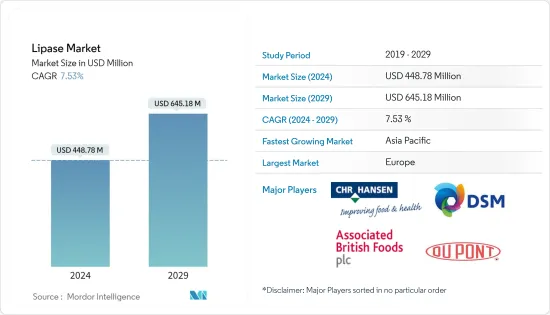 |
市場調査レポート
商品コード
1432921
リパーゼ:市場シェア分析、産業動向・統計、成長予測(2024~2029年)Lipase - Market Share Analysis, Industry Trends & Statistics, Growth Forecasts (2024 - 2029) |
||||||
● お客様のご希望に応じて、既存データの加工や未掲載情報(例:国別セグメント)の追加などの対応が可能です。 詳細はお問い合わせください。
| リパーゼ:市場シェア分析、産業動向・統計、成長予測(2024~2029年) |
|
出版日: 2024年02月15日
発行: Mordor Intelligence
ページ情報: 英文 90 Pages
納期: 2~3営業日
|
- 全表示
- 概要
- 目次
リパーゼ市場規模は2024年に4億4,878万米ドルと推定され、2029年には6億4,518万米ドルに達すると予測され、予測期間中(2024-2029年)のCAGRは7.53%で成長すると予測されます。

主なハイライト
- リパーゼは、多様な触媒活性、短期間での高い生産能力、容易な遺伝子操作など、いくつかの特徴を持つことから、動物由来のものに比べ、微生物由来のものが主流です。
- 健康的で非化学的な原料の必要性に対する人々の意識の高まりが、動物飼料を含むいくつかの産業にエリパーゼ酵素の使用を促しています。
- リパーゼ特許に関する法規制が世界的に透明性を欠いていることが、市場成長の主な阻害要因となっています。
リパーゼ市場動向
飲食品産業への幅広い応用
微生物リパーゼは、その基質特異性から食品産業で広く利用されています。リパーゼは温和な条件下で作用し、有機溶媒に対して非常に安定です。食品産業で使用される一般的なリパーゼには、リゾホスホリパーゼ、ホスホリパーゼ、トリアシルグリセロールなどがあります。リパーゼは、短鎖脂肪酸のエステル合成による風味の改質、脂肪トリグリセリドの選択的加水分解による遊離脂肪酸の遊離、食肉や魚製品などの食品中の脂肪分の除去による赤身肉の製造、ソーセージ製造の発酵段階における熟成中に遊離する長鎖脂肪酸の操作など、油脂の加工に広く使用されています。
欧州が市場で大きなシェアを占める
加工食品に対する需要の高まりと健康志向の高まりが、欧州の食品業界におけるリパーゼを含む酵素の成長を大きく後押ししており、これが世界のリパーゼ市場の成長を牽引しています。市場セグメンテーションでは、炭水化物分解酵素が市場を独占し、プロテアーゼとリパーゼがそれに続いています。欧州ではパンや焼き菓子の消費が多いため、ベーカリーが同地域最大の用途分野となっています。ベーカリー分野では、リパーゼは生地の安定性を向上させ、最終製品の保存性を高めるのに役立っています。リパーゼの乳製品分野での使用は、チーズ加工に広く使用されており、第2位となっています。欧州では遺伝子組み換え菌株を生産する新技術が登場しており、劣悪な操作条件下でも性能を発揮し、プロセス効率を向上させることができます。
リパーゼ産業の概要
世界のリパーゼ市場は競争が激しく、細分化された市場です。リパーゼはさまざまなエンドユーザー産業で幅広く利用されているため、積極的な企業は生産設備の拡充や製品革新に乗り出し、世界市場で大きなシェアを獲得しようとしています。一部の大手企業は、海外の小規模メーカーを買収することで、世界のプレゼンスを拡大しています。一方、デュポンなどの企業は、製品の販売促進を強化し、強力な販売を達成するために、マーケティングやブランディングに投資しています。
その他の特典:
- エクセル形式の市場予測(ME)シート
- 3ヶ月間のアナリストサポート
目次
第1章 イントロダクション
- 調査の成果
- 調査の前提
- 調査範囲
第2章 調査手法
第3章 エグゼクティブサマリー
第4章 市場力学
- 市場促進要因
- 市場抑制要因
- ポーターのファイブフォース分析
- 新規参入業者の脅威
- 買い手・消費者の交渉力
- 供給企業の交渉力
- 代替品の脅威
- 競争企業間の敵対関係の強さ
第5章 市場セグメンテーション
- 由来別
- 動物
- 微生物
- 用途別
- 乳製品
- ベーカリー・菓子類
- 動物飼料
- その他の用途
- 地域別
- 北米
- 米国
- カナダ
- メキシコ
- その他北米地域
- 欧州
- スペイン
- 英国
- フランス
- ドイツ
- イタリア
- その他欧州
- アジア太平洋
- 中国
- 日本
- インド
- オーストラリア
- その他アジア太平洋地域
- 世界のその他の地域
- 南米
- 中東
- アフリカ
- 北米
第6章 競合情勢
- 市場シェア分析
- 各プレイヤーの戦略
- 最も活発な企業
- 企業プロファイル
- Chr. Hansen Holdings A/S
- Koninklijke DSM N.V.
- Associated British Foods PLC
- E. I. Du Pont De Nemours and Company
- Advanced Enzyme Tech
- Amano Enzyme
- Clerici-Sacco Group
- Renco Newzealand
第7章 市場機会と今後の動向
The Lipase Market size is estimated at USD 448.78 million in 2024, and is expected to reach USD 645.18 million by 2029, growing at a CAGR of 7.53% during the forecast period (2024-2029).

Key Highlights
- Lipases are majorly derived from microbial sources, compared to animal sources, due to several features, such as the variety of catalytic activities, high production capacity in a short time, and easy genetic manipulations.
- The rising awareness among people, about the need for healthy and non-chemical ingredients, is pushing several industries including animal feed to uselipase enzymes.
- The lack of transparency in the laws and regulations, concerninglipase patentsacross the world, is a primary restraining factor for the market growth.
Lipase Market Trends
Wide Application In Food And Beverage Industry
Microbial lipases are widely used in the food industry, due to their substrate specificity. They work under mild conditions and are highly stable in organic solvents. Some of the common lipases used in the food industry include lysophospholipase, phospholipase, triacylglycerol, and so on. They are widely used in the processing of fats and oils, such as: modification of flavors through the synthesis of esters of short-chain fatty acids or selective hydrolysis of fat triglycerides to release free fatty acids, elimination of fat content in several food products, such as meat and fish products, to produce lean meat and also the lipases play a vital role at the fermenting stage of sausage manufacturing, by manipulating long-chain fatty acids, which are released during ripening.
Europe Holds A Significant share in The Market
Growing demand for processed foods, coupled with increasing awareness about health-conscious products is significantly propelling the growth of enzymes including lipase in the European food industry, which in turn is driving the growth of the world's lipase market. In terms of the type segmentation, carbohydrases dominate the market, followed by proteases and lipases. Due to the high consumption of bread and baked goods in Europe, the bakery is the largest application segment in the region. In the bakery segment, lipase help by improving dough stability and increasing the shelf life of end products. The use of lipase in the dairy industry comes in second with the wide use of lipase in cheese processing. New technologies are emerging in Europe to produce genetically modified organisms strains, which can perform in adverse operational conditions and improve process efficiency.
Lipase Industry Overview
The global lipase market is a highly competitive and fragmented market with increasing presence of global as well as regional players across the globe. Owing to the wide application of lipase in different end-user industries the active players are embarking on expanding their production facility as well as product innovation to attain significant market share in the global market. Some of the major players are expanding their global presence by acquiring small scale manufacturers in foreign countries. While companies such as DuPont, are investing in marketing and branding to increase their product promotion and achieve strong sale.
Additional Benefits:
- The market estimate (ME) sheet in Excel format
- 3 months of analyst support
TABLE OF CONTENTS
1 INTRODUCTION
- 1.1 Study Deliverables
- 1.2 Study Assumptions
- 1.3 Scope of the Study
2 RESEARCH METHODOLOGY
3 EXECUTIVE SUMMARY
4 MARKET DYNAMICS
- 4.1 Market Drivers
- 4.2 Market Restraints
- 4.3 Porter's Five Forces Analysis
- 4.3.1 Threat of New Entrants
- 4.3.2 Bargaining Power of Buyers/Consumers
- 4.3.3 Bargaining Power of Suppliers
- 4.3.4 Threat of Substitute Products
- 4.3.5 Intensity of Competitive Rivalry
5 MARKET SEGMENTATION
- 5.1 By Source
- 5.1.1 Animal
- 5.1.2 Microbial
- 5.2 By Application
- 5.2.1 Dairy
- 5.2.2 Bakery and Confectionery
- 5.2.3 Animal Feed
- 5.2.4 Other Applications
- 5.3 Geography
- 5.3.1 North America
- 5.3.1.1 United States
- 5.3.1.2 Canada
- 5.3.1.3 Mexico
- 5.3.1.4 Rest of North America
- 5.3.2 Europe
- 5.3.2.1 Spain
- 5.3.2.2 United Kingdom
- 5.3.2.3 France
- 5.3.2.4 Germany
- 5.3.2.5 Italy
- 5.3.2.6 Rest of Europe
- 5.3.3 Asia-Pacific
- 5.3.3.1 China
- 5.3.3.2 Japan
- 5.3.3.3 India
- 5.3.3.4 Australia
- 5.3.3.5 Rest of Asia-Pacific
- 5.3.4 Rest of the World
- 5.3.4.1 South America
- 5.3.4.2 Middle East
- 5.3.4.3 Africa
- 5.3.1 North America
6 COMPETITIVE LANDSCAPE
- 6.1 Market Share Analysis
- 6.2 Strategies Adopted by Players
- 6.3 Most Active Companies
- 6.4 Company Profiles
- 6.4.1 Chr. Hansen Holdings A/S
- 6.4.2 Koninklijke DSM N.V.
- 6.4.3 Associated British Foods PLC
- 6.4.4 E. I. Du Pont De Nemours and Company
- 6.4.5 Advanced Enzyme Tech
- 6.4.6 Amano Enzyme
- 6.4.7 Clerici-Sacco Group
- 6.4.8 Renco Newzealand
